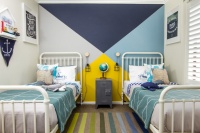Pets Make Us Wag and Purr Too, Says New Survey
http://decor-ideas.org 10/08/2015 00:13 Decor Ideas
Do pets make people happy? A new Houzz survey seems to suggest so. Of the more than 10,000 pet owners surveyed in 11 countries around the world, an overwhelming majority — from 71 percent in France to 90 percent in the U.S. — say the top benefit of owning a pet is that it makes them happy. And in the U.S., more than 70 percent of 3,100 pet owners surveyed say their pets help them reduce stress. In other words, if pet owners had tails, they’d wag them.

Miami University professor Allen R. McConnell runs a research lab that studies processes associated with human-constructed relationships, including how pets affect well-being. He says the Houzz study and his own research show that people who own pets reap a variety of positive benefits. “Pet owners are happier, have higher self-esteem, are less lonely and have more self-reported exercise and physical fitness,” McConnell says.
McConnell and other researchers at the Oxford, Ohio, college found in a 2011 study of 217 community members that pets provide as much support as siblings and parents. Only best friends ranked higher.
What’s more, the Houzz study and McConnell’s research show that many pet owners are paying this happiness back to their pets by letting them lounge on furniture, sleep in their owners’ beds and pampering them expensive dog food and special products. (No study has been done on whether a chihuahua is indeed happy in a pumpkin costume.)

Happiness is a prime benefit of pet ownership, according to U.S. respondents in Houzz’s 2015 Pets and the Home survey.
Pets on Furniture
The Houzz survey found that Americans are particularly lenient when it comes to pets, and the most likely to treat dogs and cats as members of the family.
Houzz surveyed pet owners in 11 countries: the United States, Canada, France, Italy, Spain, Sweden, Denmark, Russia, Germany, Australia and Japan.
Cats are especially likely to have free rein with furniture in the U.S. (78 percent of respondents) and least likely in France (35 percent). And dogs are also most likely to have full access to furniture in the U.S. (48 percent), and least likely in France (15%).
The same goes for beds. Cats are especially likely to snuggle up with his or her owner in the U.S. (53 percent), and least likely in France and Germany (30 percent each). Dogs are also particularly likely to sleep in their owner’s bed in the U.S. (41 percent), and least likely in Spain (14 percent).
Why do Americans allow this? It’s hard to say. “Dogs sleeping on beds and people buying sweaters for cats is more of a U.S. phenomenon,” McConnell says. “We spend over $50 billion annually in this country on pet supplies and animal care.”

He says part of our pet-pampering culture has to do with the wealth of the nation, which allows people more disposable income to spend on pets. Hal Herzog, a professor of psychology at Western Carolina University and the author of Some We Love, Some We Hate, Some We Eat, has been studying various aspects of human-animal interactions for 25 years, including cultural differences in pet keeping.

He suspects the shift in U.S. pet relations happened around the time of Lassie, pictured, the 1950s-era TV show about a boy and his collie. “The show had a big impact on kids and parents, who thought their kids needed to grow up with a dog to be psychologically happy,” Herzog says. “Then the pet products industry gets involved and feeds this with advertising.” He also points to studies done on how other media — and celebrities — influence which kinds of breeds become popular.

The 2015 Houzz pets survey found that the majority of American pet owners feel they share control of their home with their dog or cat.
Spreading Like Dander
But the phenomenon isn’t confined to our borders. Herzog says these attitudes toward pets, just like Coca-Cola, appear to be spreading around the world. Again, the Houzz survey appears to support this.
In the survey, pet owners in Australia and Italy (43 percent each) were most likely to make pet-related upgrades to their homes in the last two years. Pet owners in France were least likely, at 27 percent. Hey, what gives with France anyway? Why do the French keep popping up at the bottom of the pet data?
“The French are stricter and follow their veterinarian’s advice to give the pets a lower position than humans and keep them away from the sofa and beds for hygiene reasons, like hair and smells,” says Valerie Dramard, a veterinarian in France.


Over the border in Italy, things are the opposite. Luca Cantini, an Italian veterinary doctor specializing in animal behavior and an expert in the relationship between pets and the spaces they live in, especially homes, says she’s seeing more people remodeling their homes for pets and considering their animals to be part of the family.
“The pet-oriented homes of Italians is only a consequence of the sometimes chaotic but always love-oriented relationship Italians have with their family members: It’s a granny kind of never-ending hug that touches everyone, pets included,” Cantini says. “The big effort of Italians to offer a better living to their pets at home is linked with a new cultural leap in Italy. Pets are now part of the family and have a precise role in there.… People love to share a day out with them, a relaxed afternoon on the terrace or a [vacation]. Pets are the answer to everyone’s natural need to care and be cared for.”
Elena Ambrosimova, an editor at Houzz Russia, seemed surprised by the survey’s results that showed Russians (and the Danes) were least likely to say their pets were in charge of their home (4 percent each; Italy was the highest, at 12 percent). She sees quite the opposite. “Every pet in Russia is pretty sure it’s their house and they are the real owner,” she says. “We are like maids for them.”

She points to a popular animated cartoon about two dogs called Bobik Visits Barbos, in which Barbos gives a tour of his two-bedroom apartment while his owner is out, acting as if the furniture, refrigerator and bed are his own and the “grandpa” owner is indeed the pet. “Pets don’t have special furniture,” she says. “They have ours.”

Three pet peeves in the U.S., according to the 2015 Houzz survey of pet owners.
The Spanish are the least likely to let their pets sleep in their beds (14 percent). Ana Martin Fiestas, who works in the Houzz Spain office, says she doesn’t allow her dog to sleep in her bed. “In general, we are very concerned with our houses being clean,” she says. “It might seem silly, but I don’t think in other countries people clean as much as we do in Spain. When it comes to pets, they shed and dribble and have dirty paws, so I think it’s not very hygienic to have them in our beds.”
What, in Fiestas’ mind, constitutes a lot of cleaning? “At least in my house, my family’s and everyone’s I know, it is almost like spring cleaning every week — in my family almost every day. We clean the windows, dust, [vacuum] and mop the floors with bleach every single day.”
Hard to compete with that.
Anna Bosch, who lives in Madrid with a golden retriever, echoes Fiestas’ feeling. “I really love dogs and I pamper them, but they are still dogs,” Bosch says. “Even though you think they are clean, dogs lose a lot of hair and they smell like dogs. They do not use shoes, and all the dirt from the streets comes with them inside the house. My bedroom is my kingdom, and I want it to be as clean as possible. It is a matter of hygiene. I do not let my dog climb onto the sofas as well.”
Bosch is right about those issues. Allowing pets indoors will inevitably lead to three things: hair, dirt and odors, which the survey found to be the top pet peeves in homes throughout the 11 countries surveyed.


Are Dogs People, Too?
Of course, not everyone feels happier with a pet. If you’ve ever owned a cat that sprayed your bed or furniture when he or she was upset about something, or if you’ve experienced the diminishing importance of your pet, no matter how slight, after having children, you probably fall into this category.
Western Carolina University professor Herzog, too, is a bit of a skeptic when thinking about the link between pets and happiness, and thinks Americans in particular get out of hand with their pets. He says 70 percent of the global dog population is free-ranging, mostly living in groups around garbage dumps or attaching themselves to small villages or households, where they clean up scraps.
This, Herzog says, is better for the dog, because it more closely mimics what a dog is supposed to do. “If you had to be a dog, you’d probably rather be near a garbage dump in Mexico City than a Manhattan penthouse,” he says. “Semiwild dogs have better lives than those that live in homes with their reproductive organs cut. I’d rather be a real dog than a pet.”
He points to a 2011 study published in the journal Anthrozoos, which found that out of 60 randomly selected cultures, stark contrasts with how pets in the U.S. are treated can be seen in many of them. Many cultures keep dogs around for hunting, cleaning garbage and chasing away wild creatures, and sometimes to be killed and eaten. “They didn’t have a sense that dogs are our companions,” Herzog says.

In America, dog owners spend more on their pets than cat owners, according to the 2015 Houzz pets survey.
In an op-ed piece in The New York Times, neuroeconomics professor Gregory Berns argues that dogs are people, too, and that MRI scans he’s done on dogs show that they have the emotional capacity of a human child, and we should rethink how we treat — and discipline — them.
Herzog takes issue with this. “I don’t think dogs are people, and treating them as such isn’t good for them,” he says. One example he gives is when a homeowner imposes their own dietary preferences on their pets. Like when a vegan doesn’t feed his or her cat meat. “That’s not healthy for cats. They’re carnivores,” Herzog says.
He describes another situation where people take out large loans to pay for expensive pet care when they can’t afford it. A not-wealthy friend of his took out a $12,000 loan to pay for cancer treatments for her dog, who ended up dying a couple of years after the treatment. “If you have money and it makes you happy, I have no problem with that, but when you aren’t wealthy or you have kids, spending that kind of money is silly,” he says.

Wag On
Nevertheless, the rise in the level of companionship between humans and dogs seems to have rapidly increased in recent decades, and continues to do so. “People living alone or without kids are more likely to be more attached to their pets, and that’s a change in the last 30 years in the nature of American families,” Herzog says. “More people are living alone, living without kids, having fewer kids, having kids later, living longer — there’s a larger demographic of Americans attached to pets.”
And McConnell says there’s nothing wrong with that. “If you look at it on its face, it’s hard to justify or explain in our culture,” he says. “But if people who have pets are happier and healthier, that’s a good thing.”
See more U.S. data from the 2015 Pets and the Home survey
More
Watch These Rescued Cats Make a House Their Playland
8 Backyard Ideas to Delight Your Dog
Related Articles Recommended












